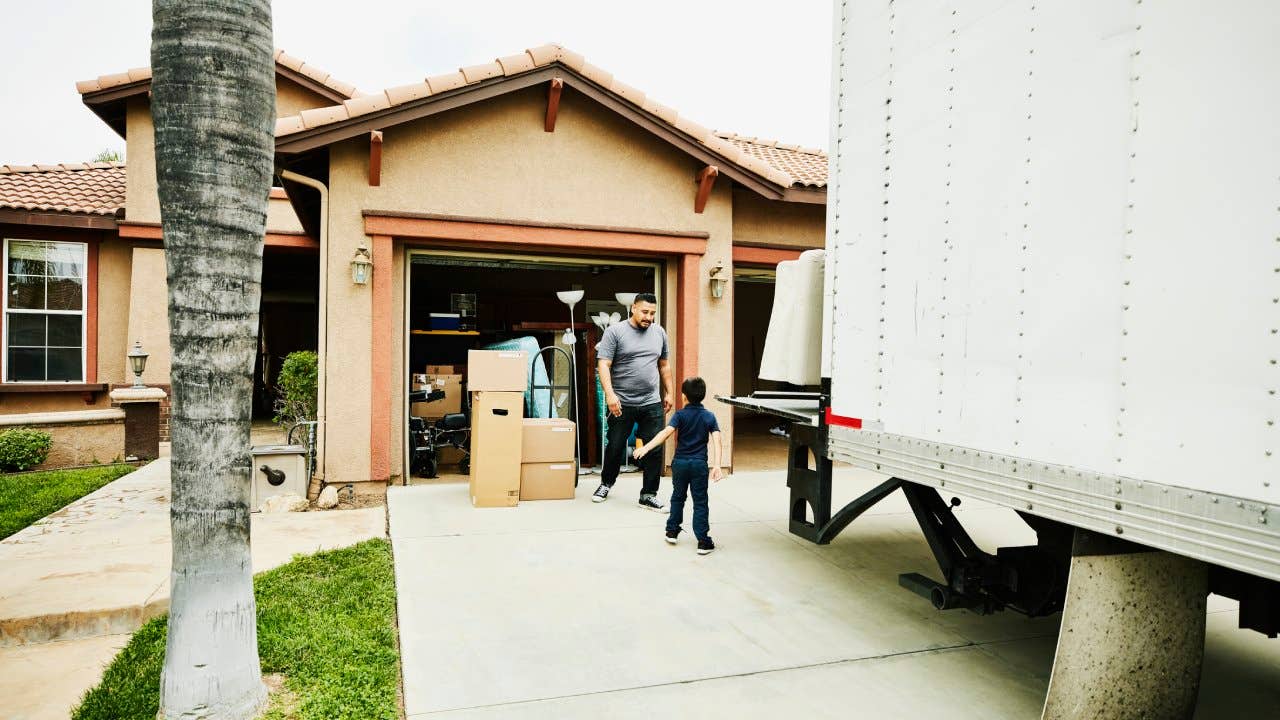How much does it cost to move across the country?

The Bankrate promise
At Bankrate we strive to help you make smarter financial decisions. While we adhere to strict , this post may contain references to products from our partners. Here's an explanation for .
With remote work becoming increasingly common, many American workers can now live and work from wherever they choose. As you consider where to live, though, it’s smart to consider the cost of relocating as well. Long-distance moves are a different animal than local ones, and they can be both costly and time-consuming. Knowing what expenses to plan for — and understanding what factors impact the price tag — can help you stay within budget when moving your life across multiple state lines. Here are some factors to think about when moving cross-country.
Average cost to move across the country
According to MyMove.com*, the cost of a coast-to-coast move can run anywhere from $3,000 for a DIY job to as much as $8,000 for professional movers. There is a lot of room within this range, and costs will fluctuate depending on the time of year and local gas prices. Many other variables can impact the price as well, including:
*MyMove is owned by Bankrate’s parent company, Red Ventures.
Transportation method
The basic expenses of getting from point A to point B, whether by plane or in a U-Haul, will likely comprise a large chunk of your moving budget. You may be loading everything into a moving container, flying and meeting up with your belongings at their destination. If this is the case, price out the cost of airfare. If you’re driving everything yourself, consider the cost of a truck rental, gas, food and possible lodging along the way.
Distance
One factor that most companies will use to help calculate the price of your move is the exact distance between your old address and your new one. Higher mileage will equal higher price.
Supplies
The cost of packing materials is often overlooked, but essentials like boxes, bubble wrap and packing tape are not free! If you are moving furniture or fragile items, you may also want to consider things like moving blankets, furniture pads, stretch wrap and mattress covers. You’ll likely need cleaning supplies on both ends of the move, as well as a hand truck, work gloves, and bungee cords, among other things. An online packing calculator can be helpful when ballparking these costs.
Shipping fees
Are you sending anything to its destination via a method other than your movers? Anything you need to send by a third party, including couriers, FedEx and potentially shipping your car, will be an added cost you should factor in.
Vacation time
Though you may not feel the cost immediately, the number of days you’ll need to take off work to tackle the move is worth considering. You may also need to enlist childcare or pet sitters for portions of the process, so that’s another cost to keep in mind.
Factors that can up the cost
Various surprise expenses are bound to crop up throughout the moving process. Airline baggage fees, tips, deposits, highway tolls and the like can all add up, so be sure to earmark a portion of the budget for the unexpected. Here are some of the hidden costs of moving you might run into:
Obstacles
Everything from road construction to narrow doorways may pose an unexpected stumbling block when it comes to your move. Anything that extends the time frame for your moving company will likely also boost the cost. If either your new or old home involves flights of stairs that must be navigated, an additional fee may apply.
Building or HOA rules
If you’re moving into an apartment building or condo, or an area that’s managed by a homeowners association, there may be set hours in which work may be done. It’s crucial to know the rules ahead of time: If your move is not complete by 5 p.m., for example, you might need to stop until morning, when work hours resume — and your moving company could charge you for an extra day. In a high-rise building, you may need to reserve a service elevator in advance.
Insurance coverage
Check your homeowner’s or renter’s insurance policy to see whether your belongings are covered in between homes. If you are using a moving company, inquire about coverage for lost, damaged or stolen items during your move. You may opt for additional insurance to include roadside assistance on your moving truck, or liability to cover any accidents or injuries that may occur.
Storage
If you need to store belongings in between your old home and your new one, there will be the additional cost of a storage unit, plus the cost of insurance on its contents if needed. Depending on the logistics of your move, you may need to hire movers to get things from your old home to a storage site, and again from storage to your new home. Some moving companies will hang on to your stuff for you until you’re ready — for a fee, of course.
Specialty costs
Are there any unique items in your home that may be tricky to move? A grandfather clock, piano, hot tub or other bulky and valuable items could run you extra to pack and transport. Check with your moving company to see whether there are preset fees for moving such belongings, so they don’t take you by surprise.
Tips to save money on cross-country moves
- Time is money! Plan ahead and stay organized — these moving checklists can help keep you on track.
- Don’t just go with the first moving company that says yes: Get quotes from multiple companies to find the best deal. Be sure to ask questions and read the fine print so that you know all the fees that may apply.
- Source free boxes from friends, coworkers and local retailers. You might even cast a net on social media asking for leftover packing supplies.
- Move only what you really need. The more stuff you have, the more movers will charge you, so selling or giving away items you don’t need will increase your savings.
- As in any business, some times are busier than others for movers. The same move might cost less at different times of year, or even different days of the week. If your moving dates are flexible, consider scheduling it in the middle of the month or during the week to save money.
- Use Bankrate’s cost of living calculator to compare how much your day-to-day expenses will cost from your old city to your new one. There may be hidden savings in your new hometown you didn’t even know about.
Bottom line
A cross-country move is a logistical undertaking that can cost thousands of dollars. But there are steps you can take to keep costs at a minimum. Planning ahead, staying organized and keeping an eye out for hidden costs will help you stay on track and on budget.
Related Articles



